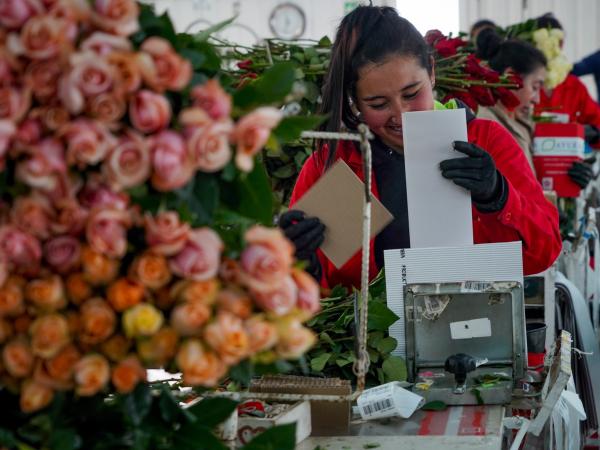Flower growers in Colombia, as every year, have been getting the most out of flower exports, especially red roses technically known as freedom, due to the date close to Valentine’s Day. Only This market represents between 30% and 35% of the sector’s annual exports.
(Read: What do flowers have to do with celebrating Valentine’s Day?).
This date that is commemorated on February 14 in the United States and other regions of the world, Today they have been importing the Colombian product for 50 years, that Asocolflores was consolidated as the union of the sector.
Just in 2022 the sales of this sector were US$2,052 million, with a growth of 20% compared to 2021 (US$1.730 million). Today this production chain is positioned as the second most exported market in the country, after coffee.
The diversity of flower products has allowed Colombia to be an important player in the international market, from the moment the plant takes rootuntil the stem is cut and the export logistics process begins, according to what was said by Augusto Solano, president of Asocolflores.
It should be noted that in 2022only the export of flowers for Valentine’s Day was 58,000 tons where the output of red roses stood out, but also of other species such as carnations, which give rise to bouquets, which are marketed abroad.
According to Solano, this season represents between 85% and 90% of exports to the North American nation. However, to a lesser extent it is also marketed in Japan and Russia.
(In addition: Inflation and high costs, the main challenges of the flower sector).
Valentine’s Day is also an opportunity within the labor market, taking into account that this is one of the sectors of agriculture that it generates at least 200,000 direct and indirect jobs and where 60% of them are represented by women.
They and the men are in charge of cultivating and caring for the different requirements of the flowers for export.
Some of these requirements, such as red roses, at the time of cultivation need an ideal temperature so that in 78 days it can be cut and marketed.
Like the requirement that the client asks for, whether the flower is more open or closed, and even the cut size of the stem.
colombian flowers
Mauricio Moreno. TIME
Two large companies in Colombia distribute flowers for Valentine’s Day throughout the world, and especially in the United States: Avianca Cargo and Latam.
(Keep reading: Century 21 bets on tourist housing with a rental platform).
From the red airline, 20% of the annual national production is exported for this festivity, this in just three weeks, which, hand in hand with flower growers, leverage exports, making these dates a fruitful economic season.
When they reach your hands, after refrigerated transport at between 2° and 8°, Avianca continues to maintain its cold chain and treat them with the utmost care.
“When one sees from the point of view of the crop itself, the flower can never lose its cold chain and at Avianca Cargo, we have the highest certifications to ensure that. In addition, you have to be careful that the flowers are not destroyed, so you have to move the flower from the crop to the tip of the other side of the world and maintain its perfect quality.”, assured Gabriel Oliva, CEO of Avianca Cargo.
Only in 2022, among other products, Avianca cargo transported, more than 18,000 tons of flowers in 300 trips and Latam 15,000 tonswhich represented an increase of 16% compared to 2021.
However, economic challenges, in addition to the climate, have added to the list of concerns of the entire sector chain.
“Since the pandemic, more flowers began to be consumed, to put them at home. Now it catches us in a time of recession and global changes. We’ll have to see where that takes us, year on year it’s down 19%, but this industry is all about cycles and it’s a very dynamic thing.”, assured the CEO of Avianca Cargo.
Now, after much care and reaching the final destination, Colombian flowers colonize American supermarkets, making 80% of the bouquets in these establishments have the tricolor flag.
PAULA GALEANO BALAGUERA AND DIANA K. RODRÍGUEZ T.
Portfolio Journalists








![[Img #74675]](https://thelatestnews.world/wp-content/uploads/2024/12/They-discover-a-new-class-of-X-ray-sources-in-the-150x150.jpg)



